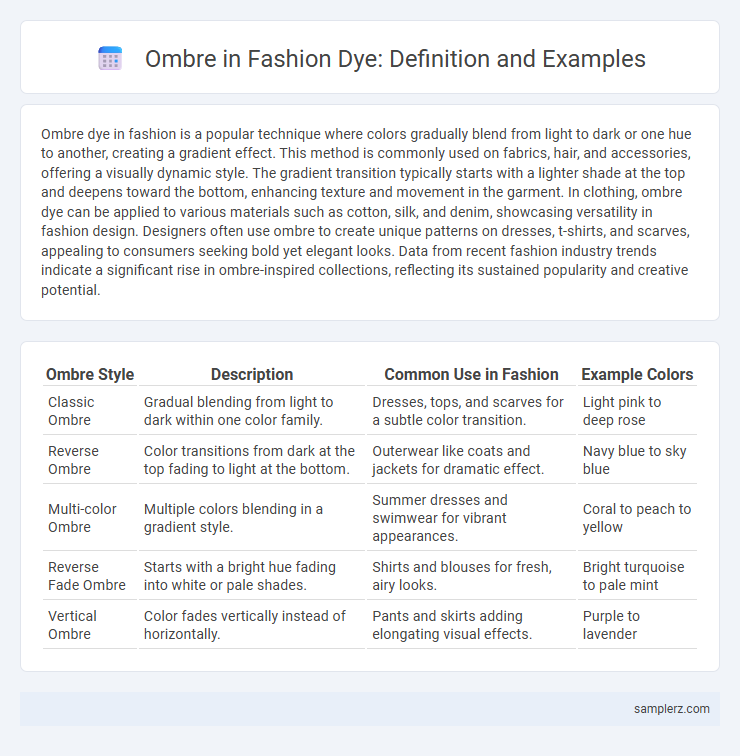Ombre dye in fashion is a popular technique where colors gradually blend from light to dark or one hue to another, creating a gradient effect. This method is commonly used on fabrics, hair, and accessories, offering a visually dynamic style. The gradient transition typically starts with a lighter shade at the top and deepens toward the bottom, enhancing texture and movement in the garment. In clothing, ombre dye can be applied to various materials such as cotton, silk, and denim, showcasing versatility in fashion design. Designers often use ombre to create unique patterns on dresses, t-shirts, and scarves, appealing to consumers seeking bold yet elegant looks. Data from recent fashion industry trends indicate a significant rise in ombre-inspired collections, reflecting its sustained popularity and creative potential.
Table of Comparison
| Ombre Style | Description | Common Use in Fashion | Example Colors |
|---|---|---|---|
| Classic Ombre | Gradual blending from light to dark within one color family. | Dresses, tops, and scarves for a subtle color transition. | Light pink to deep rose |
| Reverse Ombre | Color transitions from dark at the top fading to light at the bottom. | Outerwear like coats and jackets for dramatic effect. | Navy blue to sky blue |
| Multi-color Ombre | Multiple colors blending in a gradient style. | Summer dresses and swimwear for vibrant appearances. | Coral to peach to yellow |
| Reverse Fade Ombre | Starts with a bright hue fading into white or pale shades. | Shirts and blouses for fresh, airy looks. | Bright turquoise to pale mint |
| Vertical Ombre | Color fades vertically instead of horizontally. | Pants and skirts adding elongating visual effects. | Purple to lavender |
What Is Ombré Dye?
Ombre dye is a hair coloring technique characterized by a gradual blending of one color to another, typically transitioning from dark roots to lighter ends or vice versa. This effect creates a natural, sun-kissed look with seamless color gradients that enhance depth and dimension in hair. Popular in fashion trends, ombre dye offers versatile customization, allowing for bold or subtle color shifts tailored to individual style preferences.
History of Ombré in Fashion
Ombre dyeing originated from ancient textile traditions, with early examples found in Japanese Shibori and Indian Bandhani techniques that gradually transitioned fabrics from light to dark hues. The term "ombre," derived from the French word for "shaded," gained popularity in Western fashion during the 19th century when Victorian designers embraced gradient color effects in silk and satin garments. Modern fashion revived ombre dyeing in the early 2000s, making it a staple in hair coloring, apparel, and accessories by enhancing visual depth and artistic expression.
Popular Ombré Techniques for Fabric
Popular ombre techniques for fabric include dip dyeing, where the fabric is gradually submerged into the dye to create a smooth gradient effect. Another method is spray dyeing, which uses a spray bottle to apply color transitions that offer a softer, more controlled blend. Digital printing also enables precise ombre patterns on fabric, allowing designers to produce complex and customizable gradients with high accuracy.
Ombré in Haute Couture Collections
Ombre dye techniques have become a signature element in haute couture collections, showcasing seamless color transitions from light to dark or between contrasting hues. Designers like Dior and Valentino frequently incorporate ombre effects on luxurious fabrics such as silk chiffon and organza to enhance texture and depth. This gradient approach adds dynamic visual interest and elevates the artistry of bespoke couture garments.
DIY Ombré Dyeing for Clothes
DIY ombre dyeing for clothes transforms ordinary garments into trendy fashion statements by blending colors seamlessly from light to dark. Achieving this effect involves gradual dipping or spraying techniques with fabric dye, typically using cotton or linen materials for optimal absorption. Home crafters often utilize professional brands like Rit or Dylon to enhance vibrancy and ensure colorfastness in their personalized ombre creations.
Ombré in Denim: Trend Examples
Ombre denim showcases a seamless gradient effect, transitioning from deep indigo at the waistband to a lighter washed-out hue near the hems. Popular examples include ombre jeans with a darker top and faded bottom, creating a stylish contrast that enhances casual streetwear looks. Brands like Levi's and Madewell have embraced this trend, offering versatile pieces that blend classic denim with modern color fades.
Celebrities Sporting Ombré Fashion
Celebrities like Beyonce, Kim Kardashian, and Gigi Hadid have popularized the ombre trend by showcasing vibrant hair dye that transitions smoothly from dark roots to lighter tips. Ombre dresses worn by stars at major events, such as the Cannes Film Festival, highlight the appeal of gradient colors in high fashion. This dye technique enhances visual depth and has become a staple in celebrity runway looks and street style alike.
Ombré Accessories: Scarves, Bags, and Shoes
Ombre accessories, including scarves, bags, and shoes, showcase a seamless gradient of colors, creating a visually striking effect that enhances any outfit. Scarves with ombre dye transition smoothly from light to dark tones, adding depth and dimension to neckwear. Bags and shoes featuring ombre designs elevate fashion ensembles by blending multiple hues, making them versatile statement pieces in contemporary wardrobes.
Seasonal Ombré Color Palettes
Seasonal ombre color palettes in fashion showcase smooth gradients reflecting nature's cycles, such as warm oranges fading into deep reds for autumn or cool blues blending into icy pastels for winter. Spring features soft pinks transitioning to fresh greens, while summer emphasizes vibrant yellows merging into oceanic turquoises. These dynamic dye techniques enhance garment depth and visual appeal, aligning with seasonal color trends.
Ombré in Sustainable Fashion Brands
Ombre dye techniques are increasingly adopted by sustainable fashion brands to reduce water and chemical use, promoting eco-friendly production. Brands like Patagonia and Eileen Fisher utilize plant-based ombre dyes, ensuring vibrant gradients without harmful pollutants. This approach enhances fabric aesthetics while aligning with ethical and environmental values in modern sustainable fashion.

example of ombré in dye Infographic
 samplerz.com
samplerz.com